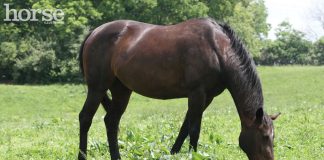
Young horses don’t have it easy. New homes, new herd mates, new careers and new routines. On top of constant changes, they have an immature immune system, which can create the perfect opportunity for an infectious respiratory disease to strike. Think of your young horses as kids going to school for the first time. They are going to be exposed to viruses and bacteria they have not built immunity to, and without proper veterinarian-guided vaccinations, your young horses may run into respiratory problems requiring costly time away from training.
Results from an ongoing study conducted by Nicola Pusterla, D.V.M., Dipl. ACVIM, at the University of California-Davis funded by Merck Animal Health, support this theory. In this study, U.S. veterinarians were enrolled in a voluntary surveillance program. They collected blood and nasal secretions from horses presented with signs of acute Infectious Upper Respiratory Disease (IURD) and/or acute onset of neurologic disease. Since 2008, more than 3,200 horses, mules and donkeys have been tested for the four major IURD pathogens: Equine Herpesvirus-1 (EHV-1); Equine Herpesvirus-4 (EHV-4); Equine Influenza virus (EIV) and Streptococcus equi, subspecies equi.
Age matters
Of the horses tested in the study, more than 50 percent were younger than 5 years of age. Because young horses are at moderate- to high-risk of contracting an infectious respiratory disease, talk with your veterinarian about selecting a vaccine that stimulates a more protective, relevant immune response. One vaccine that should be considered for all horses at higher risk for equine influenza, including older foals, yearlings and young horses, is Flu Avert® I.N. This modified-live intranasal vaccine is the only influenza vaccine that requires only one dose for primary immunization. Vaccine challenge studies conducted by veterinary researcher Hugh Townsend, D.V.M., MSc, support an onset of immunity of five to seven days in naïve horses1. The vaccine’s rapid onset of immunity can be especially useful for the older foal’s first EIV vaccine because the inactivated-virus EIV vaccines require a two- or three-dose series to achieve optimum immune response. This means foals vaccinated with Flu Avert I.N. are protected many weeks earlier than foals vaccinated with a two- or three-dose primary series killed virus EIV vaccine. Additionally, if your young horse is exposed to an influenza outbreak, there is evidence supporting the use of Flu Avert I.N. to help reduce occurrence, severity and duration of disease.
Know the signs of IURD to protect your youngster.
The horses enrolled in the research study presented the following clinical signs of IURD:
- Nasal discharge (76%)
- Fever (56%)
- Depression/anorexia (47%)
- Cough (45%)
- Limb edema/swelling (8.5%)
- Ocular discharge (8.4%)
Most horses will show fever as one of the first signs of an IURD. Monitor your horse’s rectal temperature on a regular basis so you know what its “normal” (99 to 101 degrees Fahrenheit) temperature is and can detect any variances early. Horses with an EHV-1, EHV-4 and/or EIV infection will show flu-like symptoms such as a runny nose, dry cough and muscle soreness. Horses with strangles often have enlarged lymph nodes in their head and neck that may eventually break open.
Proper biosecurity is critical
All four of the major IURDs are highly contagious and can spread rapidly through a barn if precautionary measures are not taken. In addition to a veterinarian-guided vaccination program, there are management protocols that can help protect your horses from IURDs.
Because young horses are more susceptible to these diseases, it is recommended to keep them separate from mature horses if possible. This is especially true for broodmares that can abort their foals due to an EHV-1 infection. Try to house horses by age, use and/or gestation status. It also is important to quarantine any horses showing signs of IURD as early as possible and to quarantine all new arrivals for 21 days.
Good hygiene also can help protect your horses from IURDs. Soap and water can remove the contagious organic matter from many of the objects that your horse is exposed to – stalls, buckets, bits, brushes and the hands of the people who come in contact with them.
Air quality – both at home and while traveling – also is an important measure in preventing an IURD. Keep barns and trailers well ventilated at all times and minimize your horse’s exposure to ammonia and dust.
To learn more
If you think your young horse may be at risk for contracting an IURD, contact your veterinarian to discuss a vaccination and biosecurity protocol to protect your horse. To watch an informational webinar on equine influenza and preventing influenza outbreaks presented by Dr. Pusterla, visit www.EIVWebinar.com.
Further Reading
Heaves in Horses
Help for a Horse with Heaves
1Townsend HGG: Onset of protection against live-virus equine influenza challenge following vaccination of naïve horses with a modified-live vaccine.
By D. Craig Barnett, D.V.M. is Senior Equine Technical Services Veterinarian for Merck Animal Health.






Interesting! I hope that everyone’s weekend was both great and safe, are having a great week and I hope that they have another great weekend.
Interesting.